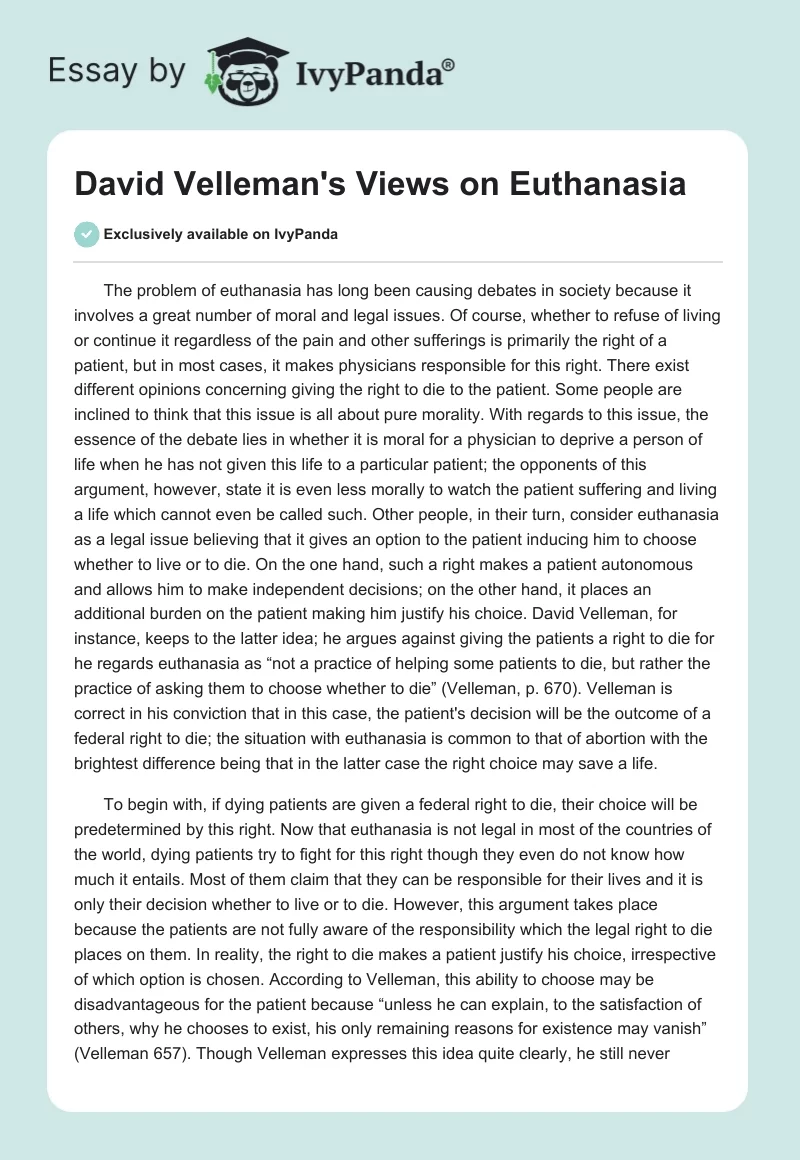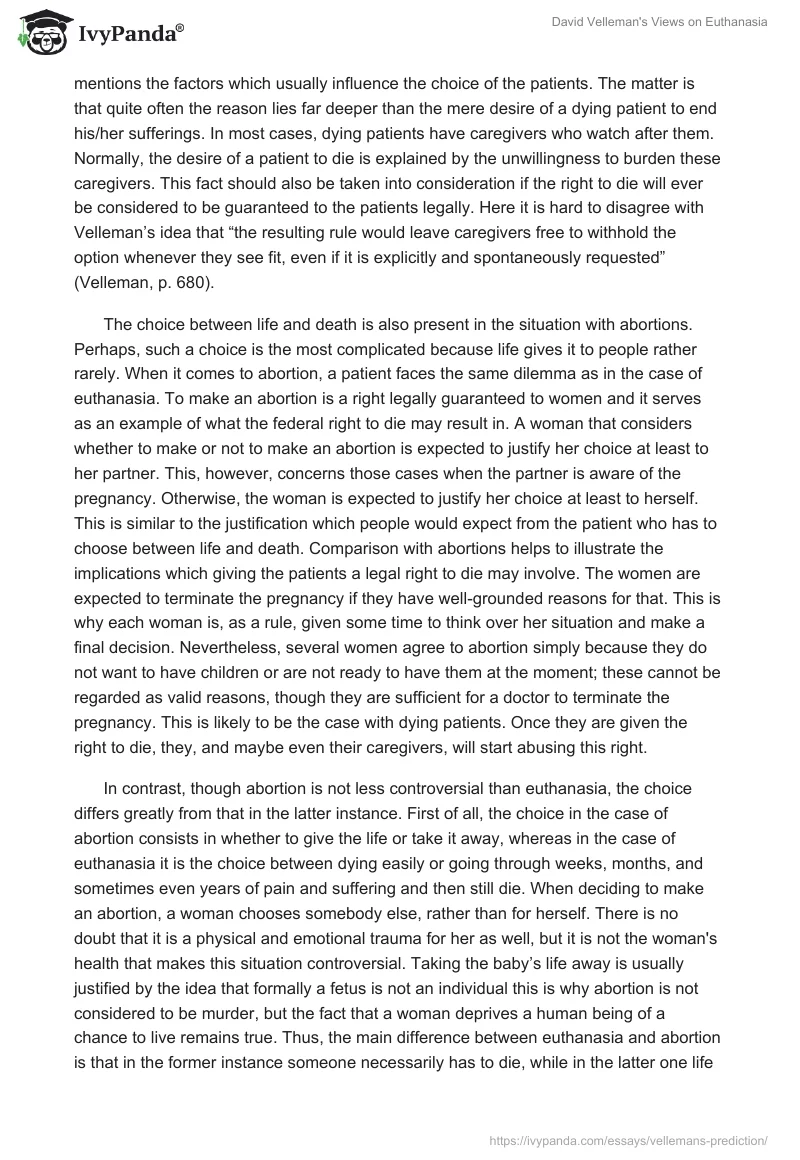The problem of euthanasia has long been causing debates in society because it involves a great number of moral and legal issues. Of course, whether to refuse of living or continue it regardless of the pain and other sufferings is primarily the right of a patient, but in most cases, it makes physicians responsible for this right. There exist different opinions concerning giving the right to die to the patient. Some people are inclined to think that this issue is all about pure morality.
With regards to this issue, the essence of the debate lies in whether it is moral for a physician to deprive a person of life when he has not given this life to a particular patient; the opponents of this argument, however, state it is even less morally to watch the patient suffering and living a life which cannot even be called such. Other people, in their turn, consider euthanasia as a legal issue believing that it gives an option to the patient inducing him to choose whether to live or to die. On the one hand, such a right makes a patient autonomous and allows him to make independent decisions; on the other hand, it places an additional burden on the patient making him justify his choice.
David Velleman, for instance, keeps to the latter idea; he argues against giving the patients a right to die for he regards euthanasia as “not a practice of helping some patients to die, but rather the practice of asking them to choose whether to die” (Velleman, p. 670). Velleman is correct in his conviction that in this case, the patient’s decision will be the outcome of a federal right to die; the situation with euthanasia is common to that of abortion with the brightest difference being that in the latter case, the right choice may save a life.
To begin with, if dying patients are given a federal right to die, their choice will be predetermined by this right. Now that euthanasia is not legal in most of the countries of the world, dying patients try to fight for this right though they even do not know how much it entails. Most of them claim that they can be responsible for their lives and it is only their decision whether to live or to die. However, this argument takes place because the patients are not fully aware of the responsibility which the legal right to die places on them. In reality, the right to die makes a patient justify his choice, irrespective of which option is chosen.
According to Velleman, this ability to choose may be disadvantageous for the patient because “unless he can explain, to the satisfaction of others, why he chooses to exist, his only remaining reasons for existence may vanish” (Velleman 657). Though Velleman expresses this idea quite clearly, he still never mentions the factors which usually influence the choice of the patients. The matter is that quite often the reason lies far deeper than the mere desire of a dying patient to end his/her sufferings.
In most cases, dying patients have caregivers who watch after them. Normally, the desire of a patient to die is explained by the unwillingness to burden these caregivers. This fact should also be taken into consideration if the right to die will ever be considered to be guaranteed to the patients legally. Here it is hard to disagree with Velleman’s idea that “the resulting rule would leave caregivers free to withhold the option whenever they see fit, even if it is explicitly and spontaneously requested” (Velleman, p. 680).
The choice between life and death is also present in the situation with abortions. Perhaps, such a choice is the most complicated because life gives it to people rather rarely. When it comes to abortion, a patient faces the same dilemma as in the case of euthanasia. To make an abortion is a right legally guaranteed to women and it serves as an example of what the federal right to die may result in. A woman that considers whether to make or not to make an abortion is expected to justify her choice at least to her partner. This, however, concerns those cases when the partner is aware of the pregnancy. Otherwise, the woman is expected to justify her choice at least to herself. This is similar to the justification which people would expect from the patient who has to choose between life and death.
Comparison with abortions helps to illustrate the implications which giving the patients a legal right to die may involve. The women are expected to terminate the pregnancy if they have well-grounded reasons for that. This is why each woman is, as a rule, given some time to think over her situation and make a final decision. Nevertheless, several women agree to abortion simply because they do not want to have children or are not ready to have them at the moment; these cannot be regarded as valid reasons, though they are sufficient for a doctor to terminate the pregnancy. This is likely to be the case with dying patients. Once they are given the right to die, they, and maybe even their caregivers, will start abusing this right.
In contrast, though abortion is not less controversial than euthanasia, the choice differs greatly from that in the latter instance. First of all, the choice in the case of abortion consists in whether to give the life or take it away, whereas in the case of euthanasia, it is the choice between dying easily or going through weeks, months, and sometimes even years of pain and suffering and then still die. When deciding to make an abortion, a woman chooses somebody else, rather than for herself. There is no doubt that it is a physical and emotional trauma for her as well, but it is not the woman’s health that makes this situation controversial.
Taking the baby’s life away is usually justified by the idea that formally a fetus is not an individual this is why abortion is not considered to be murder, but the fact that a woman deprives a human being of a chance to live remains true. Thus, the main difference between euthanasia and abortion is that in the former instance someone necessarily has to die, while in the latter one life can be saved. Another great difference is that the number of reasons which justify abortion prevails over those which justify euthanasia.
Thus, the desire to terminate the pregnancy may be caused by rape, birth defects or medical problems, medical conditions which endanger the woman’s health if she chooses to keep the baby, birth control failure, etc, while euthanasia is caused by unwillingness to suffer pain or burden the relatives. Though the differences between these two problems prevail, they still have much in common due to the controversy of choice the patient has to make in any of the instances.
In conclusion, the issue of euthanasia is indeed controversial because the decision of whether to end the life of a patient who will die in any case or not involves certain legal problems. The main problem lies in the fact that if the right to die becomes legal, then a dying patient will have to justify the choice which he will make. Since this choice concerns the termination of life, the patient is going to bear responsibility for his decision and, as stated by Velleman, will have to justify not so much his life, as his continued existence. This necessity to justify the choice makes euthanasia similar to abortion where a patient also chooses between life and death.
Women have a legal right to abortion and often abuse this right refusing to give birth to children for inadequate reasons, which may serve as an example of what guaranteeing the patients a legal right to die may lead to. It is hard to state which of the issues, euthanasia or abortion, is more controversial, even though differences between them are more numerous than similarities. The only thing which remains clear is that reasons for abortion are more sufficient than those for euthanasia, and this is why the latter should never become a federal right of a patient.
Works Cited
Velleman, David. “Against the Right to Die.” The Journal of Medicine and Philosophy 17.6 (1992): 665-681.


